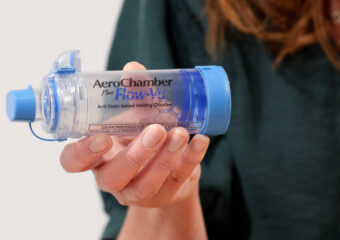Most asthma medicines are inhaled through the mouth using a handheld device called an inhaler or puffer. Different types of devices are available. The best choice for an individual depends on the medicines they need and on the person’s age, how well their lungs are working, and which devices they find easiest to use properly.
Using the right devices and technique
All adults and children need careful training from a doctor, nurse, asthma educator or pharmacist to use inhaled medicines correctly. Proper use of inhalers helps medicines work properly and can reduce the risk of side-effects. The instructions are different for each type of inhaler device.
Some medicines can be taken directly from the inhaler device, and others should be taken through a spacer (a specially designed container that attaches to a puffer and has its own mouthpiece to breathe through). Using a spacer helps increase the amount of the medicine that reaches the small airways in the lungs, compared with using a puffer on its own.
Most children aged 4 years and over can use a small spacer with a puffer. Babies and young children may need special face mask that attaches to the spacer to inhale asthma medicines.
Face masks must fit tightly around the child’s mouth and nose to make sure none of the medicine leaks out.
Spacers and face masks are available from pharmacies. Your pharmacist can help you choose which type would best suit you or your child and then show you how to use it.
People who take preventers that contain inhaled corticosteroids should rinse their mouth with water and spit after each dose, if possible.
Using spacers
Fire one puff of the medicine into the spacer, breathe in slowly and deeply, then hold your breath for about 5 seconds or as long as comfortable. Young children should breathe in and out normally for 4 breaths, before the next puff is fired into the spacer.
New plastic spacers must be washed in liquid dishwashing detergent and air-dried without rinsing (not dried with paper or a tea towel) before they are used for the first time. Otherwise they will not work properly because electrostatic charge (‘static’) will make the medicine mist stick to the walls instead of being breathed in.
More information
Visit our How-to video library on inhaler use.
Related Resources

Brochure
My Asthma Guide
My Asthma Guide is a handbook designed to help patients understand and manage their asthma.

Fact sheet
Spacer use and care
There are many different types, brands and sizes of spacers available. Ask your pharmacist, nurse or asthma educator about which spacer might be best for you or your child.
